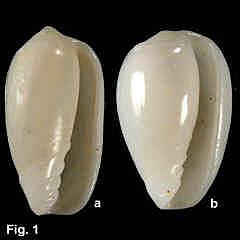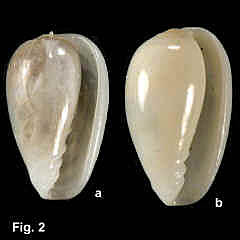|
|
|
|
|
Mesoginella olivella (Reeve, 1865) Diagnosis: Shell
small to medium, white or cream, not strongly narrowed anteriorly; spire
low; body whorl smooth; aperture moderately narrow; lip thickened
internally, smooth or weakly denticulate, thickest centrally; external
varix present; siphonal notch very
weak; posterior notch weak; thin ventral callus; columella with four
strong plaits occupying slightly less than half the aperture, 4th
plait more widely spaced. Size: Adults 5-10 mm in length. Distribution: Australian Museum Collection: Cape Moreton, Queensland , to SA, including Tasmania. Known as beach shells, and living down to 300 metres. Common. Comparison: About the same size as M. turbinata, but lacking the axial folds on the body whorl, and the spire is lower. This species shows considerable variation in shape, with some specimens being almost cylindrical, and others narrowed anteriorly and approaching M. turbinata in shape. (See Identification of beach specimens) Synonymy: Synonyms based on different forms are: Cryptospira infelix Jousseaume, 1875; Marginella binivitta Laseron, 1948; Marginella procella May, 1916 (Hewish in Wilson, 1994). Remarks: The illustrations show four forms of this species, showing variation in height of the outer lip and obesity of the shell. Fig. 1a is a narrow form, the specimen illustrated by Laseron (1948, fig. 3) as M. olivella. Fig.1b is the specimen illustrated by Laseron (1948, fig. 4) as M. infelix. Fig. 2a is a paratype of M. procella May, 1916. Fig. 2b is the holotype of Marginella binivitta Laseron, 1948. The question of the number of species involved here is not resolved. From the hundreds of lots in the Australian Museum, I can see continuous variation between the forms. Beach specimens show all the range of forms, with the narrow olivella shape being only a small proportion of the specimens. As noted by Laseron (1948, p. 37) the narrow, straight sided form does not occur in deep water (i.e. below 200 metres). Fig. 1a: North Harbour, Sydney (C.318925) Fig. 1b: Off Sow and Pigs Reef, Sydney Harbour (C.315932) Fig. 2a: Paratype of Marginella procella May, 1916. Off Schouten Island, Tasmania (C.170808) Fig. 2b: Syntype of Marginella binivitta Laseron 1948. Jervis Bay, NSW, in 27 m (C.103363) |

